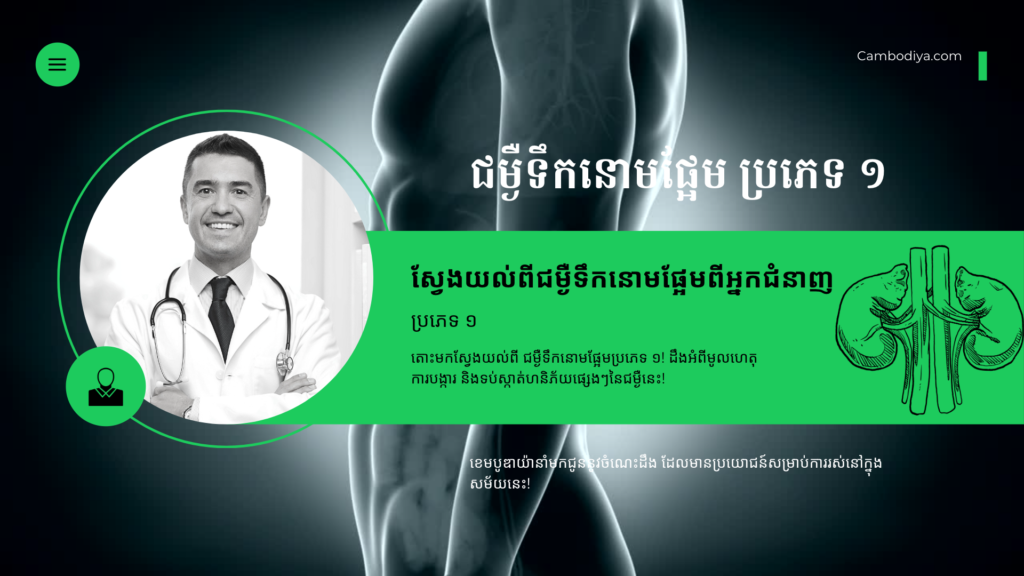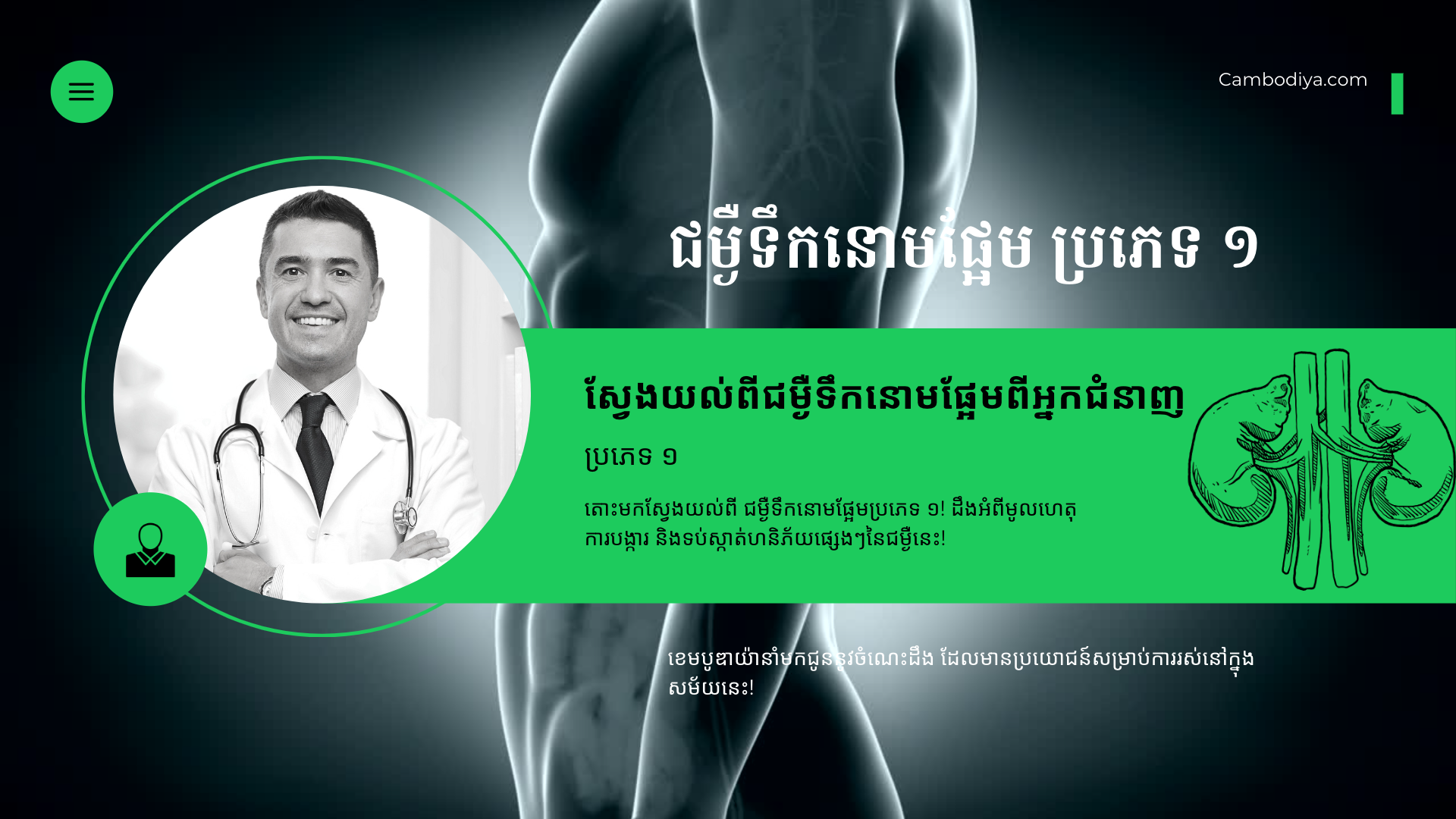Diabetes mellitus type 1
What Exactly Is Type 1 Diabetes?
12 to 15 minutes

Type 1 diabetes is a chronic illness in which your pancreas can not produce enough insulin. The pancreas is a digestive organ located behind the stomach that aids in the conversion of food into fuel. Insulin is a hormone that aids in the movement of glucose (sugar) from the blood into the cells to provide energy.
When your body does not produce enough insulin, glucose accumulates in your bloodstream. If left untreated, high blood sugar levels can harm your heart, blood vessels, nerves, kidneys, eyes, feet, and skin.1 Extremely high blood sugar levels can also result in diabetic ketoacidosis (DKA), a potentially fatal illness in which your blood becomes acidic.
kind 1 diabetes is a kind of diabetes mellitus (diabetes) that accounts for around 5% of all diabetes cases.2 While the etiology of type 1 diabetes is unknown, researchers do know that a combination of genetic and environmental causes can impair pancreatic function.
Type 1 diabetes, formerly known as juvenile diabetes, is most frequent in children and teenagers. This illness, however, can strike at any age. You may encounter symptoms such as excessive thirst, weakness, exhaustion, and abrupt weight loss if you are diagnosed with type 1 diabetes.3
There is currently no cure for type 1 diabetes. However, with insulin therapy and a healthy lifestyle, you may manage your disease and keep your blood sugar under control.4
Type 1 diabetes is classified into three subtypes: acute-onset (AT1D), slowly progressing (SP1D), and fulminant (FT1D).6
AT1D (Acute-Onset Type 1) Diabetes
People with AT1D acquire symptoms suddenly as a result of a condition known as diabetic ketoacidosis (DKA).6 DKA can occur if your body creates an abnormally large amount of ketones, which are acids generated by the liver. When your body doesn’t have enough insulin to transmit glucose (sugar) to your cells, your liver produces an excess of ketones.7
People with AT1D develop DKA less than three months after experiencing signs of hyperglycemia (high blood sugar). Symptoms may include excessive thirst, unexpected weight loss, and the need to use the restroom more frequently.8 This is the most common subtype of type 1 diabetes.
Type 1 diabetes that progresses slowly (SP1D)
Unlike type 1 diabetes, SP1D develops gradually over time. SP1D patients have antibodies that attack the insulin-producing cells in their pancreas.
SP1D can affect both children and adults. Because symptoms with this subtype can take longer to develop, it is usual for people to get this disorder later in life.9
Type 1 Diabetes Mellitus (FT1D)
FT1D is a rare type 1 diabetes variant. FT1D symptoms can appear suddenly. If you have FT1d, your immune system’s antibodies rapidly attack the cells in your pancreas that produce insulin, making symptoms difficult to manage.
If left ignored, this illness can lead to major complications and even death.10
If your pancreas isn’t making enough insulin, symptoms can appear unexpectedly. Those symptoms typically include:4
When excess sugar builds up in your system, your kidneys may try to lower the sugar by making you want to pee. You may frequently feel the need to get out of bed in the middle of the night to use the restroom. If your child has type 1 diabetes, you may discover that they are peeing the bed more frequently.
Excessive thirst: You can get dehydrated as your kidneys struggle to flush out urine or other extra fluids. When you are dehydrated, your body responds by making you thirsty.
Increased hunger: If insulin is unable to push blood sugar into cells, you may struggle to gain energy from the food you eat. You may feel more hungry if you are tired.
Because your body isn’t getting energy or sugar from the food you’re consuming, it resorts to using your body’s fat or muscle as a source of energy. You may discover that you are dropping weight without even trying.
Fatigue: Even if you get adequate sleep, you may feel weary all day because your body isn’t getting enough energy from the food you eat.
Tingling and numbness in the limbs: Nerve damage is caused by high blood sugar levels. As a result, you may get pins and needles in your hands and feet.
Diabetes weakens the immune system, resulting in sores or wounds that heal slowly. This could weaken your immune system’s ability to fight infections and heal wounds.
Blurry vision: High blood sugar levels can harm the tiny blood vessels that deliver oxygen and nutrients to your retina, the area of your eye that allows you to see properly.
Diabetic ketoacidosis (DKA) is a condition that occurs in certain patients with type 1 diabetes. This occurs when their blood sugar is extremely high. DKA symptoms include:4
Having difficulty breathing
Skin that is dry and flushed
Fruity-smelling breath
Vomiting and nausea
Cramps in the stomach
Type 1 diabetes has an unknown cause. However, researchers believe it is an autoimmune disorder that inhibits pancreatic function.
When you have an autoimmune disorder, your body starts attacking healthy cells because your immune system incorrectly believes your cells are invading your body. The body assaults beta cells in the pancreas in type 1 diabetes.4
The condition could be caused by a combination of hereditary and environmental factors. A family history of type 1 diabetes or the presence of particular genes (for example, the HLA-DR gene) can raise your risk.11 Other variables that may cause the onset of symptoms if you are predisposed to acquiring the disorder include:12 Infections
Stress
Being a resident of a frigid climate
As an infant, I was not breastfed.
Several methods can be used by a healthcare provider to diagnose type 1 diabetes. The tests listed below look for a general diabetes diagnosis.A1C test: 13 This is a hemoglobin test that examines your blood sugar in the three months preceding the test. There is no need to fast or alter your diet before an A1C test. Diabetes is diagnosed when your A1C is more than or equal to 6.5%.
FPG (fasting plasma glucose) test: This test measures your blood sugar levels. You must fast for at least eight hours before an FPG test. People frequently fast overnight before having their blood drawn in the morning. Diabetes is diagnosed when your fasting blood sugar level is greater than or equal to 126 milligrams per deciliter of blood. Because blood sugar levels might fluctuate, an FPG test should be repeated to validate the original result.
Oral glucose tolerance test (OGTT): This blood test measures your blood sugar levels over a two-hour period. A healthcare provider will first draw your blood. Then they’ll ask you to drink something sugary. They will draw your blood several times over the following two hours to see how your body stores or uses the sugar. Diabetes can be diagnosed if the blood sugar level is greater than or equivalent to 200 milligrams per deciliter of blood.
The random glucose test measures your blood sugar level at any moment. A blood sugar level more than or equal to 200 milligrams per deciliter of blood, similar to the OGTT, may result in a diabetes diagnosis. To confirm a diagnosis, a random glucose test should be performed twice.
Pregnant women may be given a glucose challenge test by their healthcare providers. You will begin by drinking a sweet beverage. A blood sample will be taken one hour later by the healthcare professional. If your blood sugar level is more than 135 milligrams per deciliter of blood, you will most likely be given an OGTT. The OGTT data can be used to make a diabetes diagnosis.
Additional blood tests will be performed by your healthcare professional to determine whether you have type 1 or type 2 diabetes. Autoantibodies, or proteins in the immune system that wrongly assault insulin-producing cells, are the primary targets of type 1 diabetes diagnostic testing. Some tests for type 1 diabetes autoantibodies include:14 autoantibodies to insulin (IAA)
Autoantibodies against insulinoma-2 (IA-2A)
Autoantibodies to the cytoplasm of islet cells (ICA)
Autoantibodies to glutamic acid decarboxylase (GADA or anti-GAD)
Autoantibody tests can also assist in determining the stage of type 1 diabetes.
Staging
Type 1 diabetes is classified into three stages:14
Stage 1: Your blood sugar levels are still normal and you are not experiencing any symptoms. You did, however, test positive for two or more autoantibodies.
Stage 2: You have no symptoms, but your blood sugar is no longer within normal limits. You have tested positive for two or more autoantibodies, and your immune system is creating cells in your body that assault insulin.
This is a formal clinical diagnosis of type 1 diabetes. You have several autoantibodies, your blood sugar is elevated, and you are experiencing symptoms such as increased thirst and exhaustion.
There is currently no cure for type 1 diabetes. Instead, the purpose of type 1 diabetes treatment is to help you manage your disease. Maintaining a balanced blood sugar level will help you improve your symptoms and live a healthier life.
If you are diagnosed with type 1 diabetes, your healthcare professional will instruct you to periodically test your blood sugar levels. You will also need to provide your body with the insulin that your pancreas is no longer producing. It is critical to take your insulin exactly as directed by your healthcare physician because missing insulin doses can result in DKA.
Your age, the severity of your condition, access to medicine, lifestyle, and insurance will all influence how you take insulin. Injections, insulin pens, and insulin pumps are all insulin delivery methods. A continuous glucose monitor (CGM) is a newer type of technology that can be linked to an insulin pump to check your blood sugar levels throughout the day and give your body insulin as needed.15
When you are diagnosed with type 1 diabetes, your healthcare practitioner may assist you in forming a diabetes care team to help you manage your disease and monitor for problems to various body parts or organs. Your medical team may include a(n):16
The Food and medicine Administration (FDA) of the United States approved a medicine named “Tzield” in November 2022, which may postpone a type 1 diabetes diagnosis in patients who are at risk for the condition. Tzield is the first licensed preventative medicine, and it comes in the form of an injectable vaccine.
Tzield clinical studies revealed that 45% of research participants who received the vaccination waited an average of 50 months (4.16 years) before being diagnosed with type 1 diabetes. Tzield is now licensed for anyone over the age of eight who are at a higher risk of developing type 1 diabetes.5
More study into new preventative techniques is still being conducted. Future research may aid healthcare providers in understanding novel strategies to prevent or reduce damage to the beta cells in your pancreas.17
You can also avoid future harm from type 1 diabetes by maintaining healthy blood sugar levels. Monitoring your blood sugar levels on a daily basis, taking your insulin dosages on time, and getting enough exercise, sleep, and healthy nutrition can all help with disease control.18
Living with type 1 diabetes can be quite difficult. It’s natural to be frustrated.
A healthy lifestyle, in addition to regular check-ins with your care team and taking your insulin on time, can help you manage your blood sugar levels. Some suggestions for improving your general lifestyle include:19
Manage stress: Excessive stress might raise blood sugar levels. Meditation, spending time with loved ones, and journaling are all activities that might help you manage stress.
Eat a healthy diet: Vegetables, fruits, complex carbohydrates, lean protein, and healthy fats can help you maintain a healthy blood sugar level.
Regular physical exercise allows your muscles to utilise sugar for energy.
Sleep well: A good night’s sleep might help you regulate your blood sugar levels.
Seek social assistance: Staying in touch with loved ones and other people who have type 1 diabetes can help you feel supported and reduce stress as you navigate life with the condition.
Type 1 diabetes occurs when your pancreas does not create enough insulin, resulting in high blood sugar levels. Type 1 diabetes symptoms may include becoming increasingly hungry or thirsty, feeling tired or weak, needing to use the restroom more frequently, and losing weight without trying.
If you are experiencing symptoms, it is critical that you contact your healthcare professional to be examined and given an accurate diagnosis. Your healthcare physician and care team can help you develop a treatment plan that will assist you in managing your condition. Early therapy can save your heart, blood vessels, nerves, kidneys, eyes, feet, and skin from additional damage.
While there is no cure for type 1 diabetes, taking your insulin on time and adopting a healthy lifestyle can help you manage your disease.






